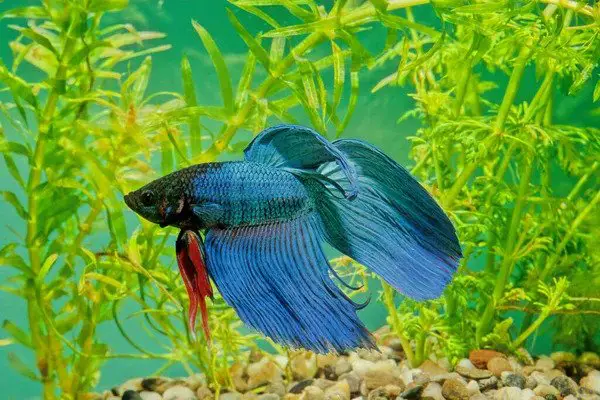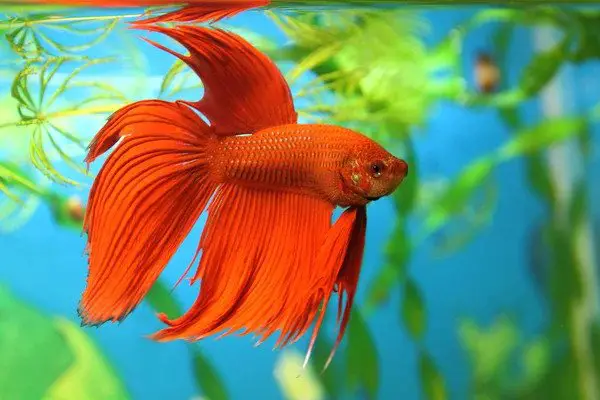Betta fish (also known as Siamese fighting fish) are a popular choice of fish in aquariums. They are interactive and bond with the humans around them quite easily. Their beautiful colors add a gorgeous look to any tank setup.
They are also easy to manage and can even survive without water for a short period. Betta fish are quite active and enjoy swimming. This makes it all the more worrying when they lay on their side.
There are many reasons for this behavior, with some being nothing to be scared about, while others can be quite worrying. Here we’ll look at them in more detail and see what you can do about it.
Why Is My Betta Fish Laying On Its Side?
Are you wondering why your betta fish is laying on its side? There is no one answer to this question. Your betta might be taking a peaceful nap or resting as they get older. On the other hand, they might be suffering from a disease, poisoning, or fungal infection.
Thus, it is important to find out the root cause of your fish’s behavior to keep them healthy.
Possible Reasons Why Betta Fish Is On Its Side

There could be many reasons why your betta is on its side. While your betta fish loves swimming around all day, they also want to take short naps now and then. The most common reason for your betta fish sitting in a corner and not moving is sleeping.
You may observe this behavior at night as their sleeping patterns resemble humans. You might also see a sleeping betta fish dozing off at the bottom of the betta tank or on top of plant leaves.
Turning on lights at night may wake them up, so be careful not to disturb them when they take a nap. It can be hard to see the difference between a sleeping and dying fish at times, but hopefully, your betta is just resting.
Here we’ll check out the other reasons why your fish may be laying at the bottom of the tank.
Age
Bettas do not only sleep like humans but also feel tired with age like us. They have a short life expectancy which gives them a life of up to five years when taken care of properly. You might not see them moving as frequently with time.
Older betta fish cannot function as well as they did during their young days. They find it convenient to sit in one corner instead of utilizing their energy to move around. You might also see them lying on the leaves or the tank’s surface.
It is easy to rule out this reason if you have had your betta for many years now. It is natural for them to move less in the old days. Remember that you may have had them for a few months only, yet they might be older than that.
Small Aquarium
Do you think that your betta is enjoying the space you have provided? They might not be. Betta likes swimming around and exploring the aquarium.
While they can live in tanks with as little as 3 gallons of water, who doesn’t like ample space! When the room is small, and your fish does not have a lot of area, they eventually sit at a side or lie at the bottom.
If you feel that your aggressive aquarium fish is tired of just swimming and needs a few elements to keep them engaged, add a few attractions in the betta tank.
Use a mix of natural embellishments and caves to make it attractive. You may also add natural flora to the tank to regulate the environment and keep your fish busy.
Unhealthy Diet
A healthy diet is critical for healthy betta fish. Their food intake affects their activity, whether they are female or male betta fish.
Too little or too much food may alter their movement, and you see your betta fish laying on side of the tank. A lesser food intake than required does not offer enough energy for the fish to move around.
On the contrary, they might get bloated from eating a lot and unable to move much. A great diet will lead to healthy fish.
Temperature or pH Fluctuation
In case you are new to keeping betta as a pet, you may be surprised that they are vulnerable to temperature changes. They prefer warm temperatures. Yet, too high temperatures in the summer season can do more harm than good.
A higher temperature in the tank results in a shortage of oxygen. They might come to the surface to breathe. But, they need an adequate oxygen supply in the tank. It is a point of concern when you see your betta panting at the bottom of the tank. Look for the signs of oxygen shortage and regulate tank temperature accordingly.
Besides temperature, the pH also influences your betta fish’s activity. Bettas like a neutral pH of 7 in the aquarium. They may also live well at 6.5 to 75 pH. A significant change in the pH can cause pH shock and lead to the death of your fish. Check on them when you see your betta fish laying on side.
Improper Filtration
Besides sleeping and temperature fluctuation, your aquarium may lack a filter leading to the accumulation of germs and toxins in the tank. If not monitored and managed properly, improper filtration in the tank leads to ammonia and nitrate poisoning.
It can cause gill issues or fin rot in betta. Ensure a steady water flow and cleaning of the tank. Do not hesitate to add a sponge filter to the filter to reduce the water current.
Ammonia or Nitrate Poisoning
Ammonia poisoning is a common issue in overcrowded small tanks. Fish waste leads to an increase in the level of ammonia in the aquarium. It is toxic for fish and may cause chemical burns in fish gills leading to death.
If you do not have a functioning filter in the tank, your fish may badly suffer from gill issues in the long term. Additionally, ammonia is not visible, making it difficult to identify rising toxin levels. Make sure to monitor and maintain the water in the tank to avoid increasing levels of ammonia. Any amount of ammonia above 0 PPM will cause harm to your betta, your betta’s tank mates, or any other fish.
The increasing amount of ammonia in the aquarium will eventually lead to a high level of nitrates as well. Ammonia is converted into nitrites by bacteria in the tank, which further converts to nitrates.
Nitrates are not as toxic as ammonia, yet they still harm your pet’s health. Bettas tend to lose their appetite on long-term exposure to nitrates. Your fish may become weak and spend their time laying on side. It also affects their respiration levels and appearance.
Your fish can tolerate 5 to 10 PPM nitrates in the system, but more than this amount will harm them. Water test equipment is suitable for monitoring nitrate levels.
Swim Bladder Disease
A fish’s swim bladder is a critical organ for swimming that helps regulate the balance and smooth swim. Your betta with a swim bladder disorder may have trouble moving and swimming. Thus, they spend a significant fraction of their time sitting at the bottom or side of the tank.
This condition typically results from overeating leading to constipation. It may become prolonged when not treated in time. A high-fiber diet is as beneficial for fish as it is for humans. Adding high-fiber foods like blanched peas can help relieve constipation and prevent swim bladder disease.
Death
The most hurtful reason your betta fish lays on the side or bottom could be their death. It pains to see your pet lose its life, yet it is a natural process, and your betta will experience it eventually. When you see your betta fish lying on the side, tap to see movement. A sick betta fish will show movement even if it’s sick.
Betta fish can live up to 5 years in an adequate environment with proper diet and care. You can improve their quality of life by providing an appropriate diet and taking care of the tank’s filtration, pH, and temperature.
Common Betta Issues and How to Treat Them

Now that you know the possible issues that might push your betta to lay on a side, we won’t leave you just there. Here are appropriate solutions to the potential problems.
Get a Bigger Tank
When you suspect your betta is getting tired and wanting more space to roam around, the best bet is to get them a bigger tank with more capacity. Many people opt for small 2.5 to 3-gallon tanks initially.
Yet, it is preferable to get a larger container of at least 5 gallons. It gives your betta ample space to swim and explore the tank. A smaller tank also gets polluted sooner and exposes your fish to more toxins.
Clean Tank
If you cannot immediately replace your small tank with a larger aquarium, be more vigilant about its cleanliness. When you feed your betta fish regularly without changing the water or checking toxin levels, ammonia and harmful microbes build in the environment.
Failing to change the tank’s water may lead to poisoning and harm your pet’s health. Shift your betta to a clean tank while you remove toxins from their home.
Medical Treatment
You may not realize ammonia or nitrate poisoning in the tank until your fish cannot take it anymore. In such cases, betta often needs adequate medical intervention to treat the condition in time. Some of the natural medicines used in treating betta fish include:
- Aquarium Salt
- Indian Almost Leaves
- Melafix
These medicines do not have any side effects because of their natural origin. Melafix can be a lifesaver if you cannot consult an expert immediately. Other fish diseases, along with their treatment, are mentioned below.
Before administering any medicine, it is essential to understand why your betta fish lay on the side. You might not be a doctor, but you can give an initial diagnosis to save your fish. It is better to consult an expert. Yet, do not hesitate to look for the underlying issue to provide first aid.
Put your betta fish in another tank with less flora to make sure the medicine does not harm other organisms.
Fungal Infections
Fungal infections are a prevalent betta fish disease. You can spot a fungal infection in the form of cotton-like patches on your pet’s body. Excess dead and decaying organic matter can lead to fungal infection when the tank is not clean. You can treat the fungal infection with salt and Betamax.
How To Treat: Firstly, shift your fish to a different tank before giving any medicine. Adding suitable salt to the tank can help eliminate fungal infections. Yet, do not add a lot, or it may harm your fish.
One tablespoon of salt is recommended for a 5-gallon tank. Also, put some Bettamax in your aquarium to eliminate fungal infection. Clean your tank thoroughly after removing fungus.
Swim Bladder Disorder
As we mentioned earlier, swim bladder disease is quite frequent in betta and limits your fish’s movement.
This disorder affects the swim bladder of your betta fish, which facilitates buoyancy. Your fish loses its ability to swim properly because of positive or negative buoyancy. Positive buoyancy keeps your fish floating, while negative buoyancy makes it difficult for them to rise to the top.
Too much exposure to oxygen (positive buoyancy) and waster accumulated at the bottom (negative buoyancy) is harmful. Besides your betta fish laying on side, other symptoms of the swim bladder disease include swimming upside down, floating at the surface, and having a bloated stomach.
How To Treat: As swim bladder disease is typically caused by poor water quality, diet problems, and infections, it is vital to fix the root issue. The best approach is to maintain a clean environment in the tank at an appropriate temperature. Reducing water levels in the tank also helps with negative buoyancy.
Fin Rot
Many times betta may experience tail or fin rot. You can notice this as your pet’s appearance begins to change. It is quite a painful condition to see your betta in.
However, you can prevent the worsening of the condition by offering timely treatment. It usually occurs due to bacteria that your betta’s immunity cannot fight.
How To Treat: You can treat fin or tail rot using antibiotics like Tetracycline and Ampicillin. It is also suitable to use an anti-fungal treatment like Bettamax to ensure thorough cleaning. Lastly, change the water in the aquarium before putting your fish back into it.
Pop Eye
If you see your betta having a bulging eye, they might have pop-eye. There is no particular reason for pop-eye in betta, yet it may be due to unclean water or bacterial infection.
It can be temporary or permanent. The initial step is to check the water in the tank for toxins and parasites. In case the water is clean, you may need to opt for antibiotic treatment.
How To Treat: Pop-eye is typically caused by a gram-positive bacteria. You may choose Maracyn or Maracyn II broad-spectrum antibiotics.
Add one packet of the medicine to a 5-gallon aquarium (calculate for your tank accordingly) on the first day. Add half a packet in 5 gallons of water for the next five days. Do a 25% water change to improve the quality of your betta’s fish.
Ich
Ich is a common aquarium protozoan that does not usually affect fish. You can identify ich in the form of white spots on betta’s body. Your pet’s immune system fights it off, yet a feeble fish may get infected. It also alters their appetite, and they do not eat much.
How To Treat: The best way to remove ich from your fish’s tank is to raise the temperature to 80° F. Add malachite green or formalin at the same temperature and monitor for 48 hours. Keep your betta in another tank for that time.
FAQs

How do you know when a betta fish is dying?
Betta fish sometimes develop diseases that may cause death. Common reasons are ich, ammonia and nitrate poisoning, and fin rot.
You can identify these issues by discoloration on your fish’s body. You may also see brown or white spots on their body. Furthermore, swelled stomach and rotting fish indicate something is wrong, and you must treat them immediately.
Why is my betta laying on its side at the bottom?
Betta fish are usually quite active, yet they might lose their motility for numerous reasons. Common reasons your betta is laying on its side at the bottom include old age, sleep, or diseases.
Negative buoyancy may also cause your betta to stay at the bottom. Make sure to find out the root cause of this behavior to provide an appropriate solution.
Why is my betta fish on its side but still alive?
Do not be afraid if your betta is on its side. If it shows movement on taping the aquarium glass, it is alive. Yet, it might be suffering from a disease that does not allow it to move much. One common reason is the swim bladder disease that affects buoyancy.
Other causes may include ich, increased toxins in the aquarium, and improper diet. A surplus diet causes bloating and hinders movement, whereas a poor diet deprives your fish of essential nutrients.
What to do if a fish is laying on its side?
Mostly your fish might be taking a nap after a busy day or bloated because of eating too much. Betta might be laying on its side because they are tired or bored. Or they might have a disease that restricts them from swimming around.
It may also be because of parasites or poisoning. Fishes can fight many pathogens independently, but they sometimes require adequate treatment.
Final Thoughts
Betta fish is a popular choice of fish in aquariums because of its beautiful colors. It adds a gorgeous vibe to the aquarium, whether living alone or with other fishes. They are quite active, yet you may sometimes see your betta fish laying on side.
It could be due to age, sleep, unclean tank, or an underlying disease. The most suitable initial response is to shift your pet betta to a quarantine tank and clean the aquarium. Monitor the temperature and pH and frequently change the water to prevent excess dead organic material.
Make sure to administer a suitable antibiotic in case of pop-eye, fin rot, or swim bladder disease. Most times, you can bring your betta back to full health and enjoy watching it explore its tank for years to come.

